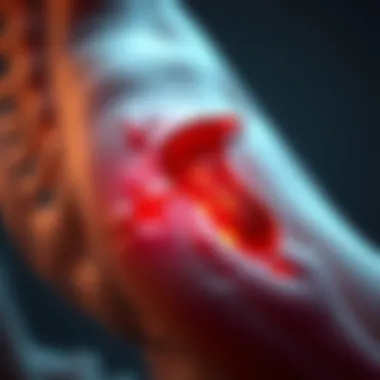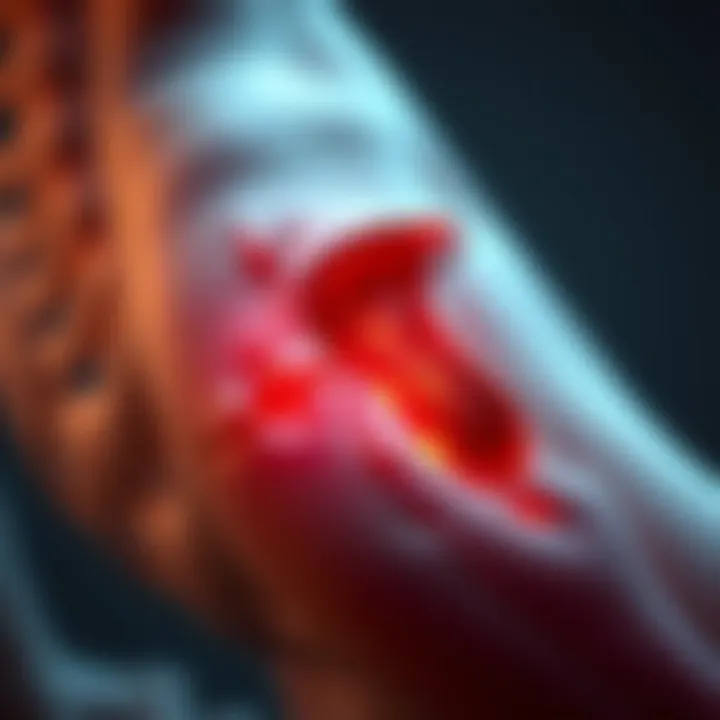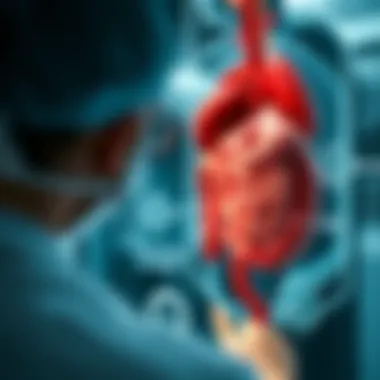Piriformis Syndrome Surgery: An In-Depth Analysis


Intro
Piriformis syndrome, though not the most common diagnosis in orthopedics, presents a unique set of challenges for those who experience its effects. The piriformis muscle, located in the buttocks region, plays an important role in the mobility and stabilization of the hip joint. When this muscle becomes tight or inflamed, it can compress the sciatic nerve, leading to pain, tingling, or weakness down the leg. Understanding this syndrome is crucial for effective treatment, especially when conservative methods fail and surgical options come into play.
Surgical interventions may be necessary for individuals suffering from persistent symptoms despite years of therapy and rehabilitation. It raises numerous questions regarding all aspects of what surgery entails, from anatomical considerations to potential recovery pathways. In this document, we aim to explore these complexities, offering clarity and insight on surgical procedures related to piriformis syndrome. This includes the definitions of relevant terms, a deep dive into findings and various treatments, together with potential complications and post-operative care strategies.
By unpacking the details of piriformis syndrome surgery, we hope to equip patients and healthcare providers with the knowledge they need to make informed decisions about treatment options.
Intro to Piriformis Syndrome
Understanding piriformis syndrome is not just for healthcare professionals; it's essential for anyone grappling with the discomfort this condition can bring. At its core, piriformis syndrome occurs when the piriformis muscle, located deep within the gluteal region, irritates the nearby sciatic nerve. It’s a painful condition that can lead to significant mobility issues and persistent pain. By recognizing symptoms early, individuals can seek appropriate treatment options before the condition exacerbates.
This article shines a light on an often-overlooked aspect of health discussions: the surgical interventions available for those whose non-invasive treatments have failed. Understanding these surgical options is paramount. It helps patients to navigate their choices more effectively and aids healthcare providers in ensuring comprehensive management of the condition.
Definition and Overview
Piriformis syndrome is characterized by sciatic pain and discomfort caused by the piriformis muscle's spasm or hypertrophy. The piriformis muscle originates from the sacrum and inserts onto the greater trochanter of the femur. Its key functions include stabilization of the hip joint along with external rotation of the thigh. When this muscle irritates the sciatic nerve, it can lead to symptoms ranging from pain to sensory changes down the leg.
To further complicate matters, the pain can feel similar to other conditions such as lumbar radiculopathy or lumbar disc herniation, making accurate diagnosis a challenge. Recognizing the art of discerning between these conditions is crucial, forming the backbone of appropriate treatment strategies.
Importance of Understanding Surgical Options
The exploration of surgical options for managing piriformis syndrome is vital for several reasons. First, it's not just about alleviating pain; it's about restoring quality of life. Surgery can sometimes provide relief when conservative methods fail, serving as a beacon of hope for many who feel trapped by their symptoms.
When the subject turns to surgery, several considerations emerge:
- Effectiveness: Not all surgeries yield the same results, thus understanding different procedures can help set realistic expectations.
- Risks: Each surgical approach carries unique risks. Familiarizing a patient with these aspects allows for informed decision-making.
- Recovery and Rehabilitation: Grasping the post-operative journey is essential in preparing for life after surgery.
Ultimately, recognizing the array of surgical options available is a pivotal step for both patients and medical professionals alike. Each individual assessment can lead to tailored solutions that meet specific patient needs, whether it be through open surgery, endoscopic techniques, or other innovative methods. This understanding fosters a collaborative approach to treatment, encouraging discussions that can pave the way toward successful surgical interventions while building confidence in navigating the complexities of treatment.
Anatomy of the Piriformis Muscle
The anatomy of the piriformis muscle is not just a medical curiosity; it’s foundational to understanding how piriformis syndrome manifests and impacts a patient's life. Grasping the structural components and functions associated with this muscle helps demystify why certain surgical interventions may be necessary. Surgery might not be the initial step in managing symptoms, but acknowledging the anatomy serves as a springboard for effective diagnosis and treatment options.
Location and Function
The piriformis muscle is tucked away deep in the buttock, originating from the anterior surface of the sacrum at the lower spine. Those who find themselves with tightness or pain in this area might want to thank this little but mighty muscle. It connects the spine to the thigh bone, playing a critical role in movement; primarily, it assists in lateral rotation of the hip joint. By allowing us to turn our legs outward, the piriformis helps in activities as simple as walking or sitting cross-legged.
Notably, it doesn’t work alone. Its position—sitting atop the sciatic nerve—means any dysfunction can lead not only to discomfort in the buttock but also radiating pain down the leg, sometimes mimicking sciatic pain. Understanding where this muscle sits and what it does is akin to knowing the script of a play to avoid casting the wrong actors; without this knowledge, diagnosis is likely to go awry.
Nerve Pathways and Muscle Interactions
The piriformis muscle is not on an island; it coexists with various nerves and muscles that intertwine in the lower extremities. The sciatic nerve, responsible for a plethora of leg sensations, passes deep to the piriformis in a majority of individuals. However, in some, it actually pierces through this muscle. This anatomical variance has significant implications for surgical candidates. If the piriformis muscle is inflamed or tight, it can cause compression on the sciatic nerve leading to symptoms that are often misdiagnosed.
When evaluating nerve pathways, the significance of this relationship cannot be overstated. The muscle’s ability to contribute to pelvic stability also comes into play. The muscles of the hip and pelvis are like a symphony; if one section plays out of tune, the perfection of movement is thrown off balance. In summary, the piriformis muscle’s location and interaction with nerve pathways underpin many of the symptoms that lead individuals down the surgical route.
"Understanding the anatomy of the piriformis muscle and its surrounding structures contributes to a clearer diagnosis and a roadmap for potential interventions."
In light of these insights, the complexities surrounding the piriformis muscle's anatomy become increasingly evident. Knowledge of these relationships can guide treatment protocols, pre-operative evaluations, and ultimately, patient outcomes.
Pathophysiology of Piriformis Syndrome
Understanding the pathophysiology of piriformis syndrome is fundamental for both medical professionals and patients. Grasping the underlying mechanisms at play is crucial for developing effective treatment strategies. At its core, the syndrome often emerges from abnormalities in the piriformis muscle, leading to various clinical manifestations. This muscle, which is located deep in the gluteal region, plays a significant role in hip stabilization and movement. When the piriformis muscle becomes tight or spasms, it can cause compression of the nearby sciatic nerve, resulting in pain and discomfort.
Etiology of the Syndrome
Piriformis syndrome can stem from several factors, making it a multifaceted condition. These may include:
- Muscle overuse: Athletes or individuals who partake in significant physical activity may experience overuse of the piriformis muscle. This can lead to inflammation and subsequent nerve compression.
- Trauma: Direct injury to the hip or buttock area can result in muscle spasm or scarring. Such traumas can disrupt the natural function of the muscle.
- Postural issues: Poor posture, particularly during prolonged sitting, can shorten the piriformis muscle and create excessive tension.
- Anatomical variations: Some individuals possess anatomical differences which can place unique strain on the piriformis muscle, exacerbating the risk of developing this syndrome.
Symptoms and Clinical Presentation
The symptoms of piriformis syndrome can vary significantly but often include a classic presentation of pain that radiates from the buttock down the leg, commonly mimicking sciatica. Patients often report:
- Pain: This can be sharp or dull in character, often intensified by certain activities such as walking or sitting for extended periods.
- Numbness: Many individuals also experience tingling or numbness in the leg, which may extend down to the toes.
- Muscle weakness: Difficulty in moving the leg during activities or climbing stairs can occur, which may contribute to a lack of balance.
Piriformis syndrome serves as a reminder that specific muscular dysfunctions can significantly impact overall neuromuscular health.
Recognition of these symptoms is vital, as it allows for timely intervention. The nuanced relationship between the piriformis muscle and the sciatic nerve highlights the importance of comprehensive assessment by healthcare providers. Improved understanding contributes to better diagnostic approaches and management plans tailored to individual patient needs. As research continues to unfold, the interplay of various elements leading to piriformis syndrome will likely become clearer, enhancing therapeutic outcomes.
Diagnosis of Piriformis Syndrome
Understanding how to properly diagnose piriformis syndrome is paramount for both effective treatment and improved patient outcomes. This elusive condition, often overshadowed by other forms of sciatica, requires careful evaluation using a combination of clinical assessments and imaging studies. Misdiagnosis or delay in diagnosis can lead to inadequate treatment plans, extended suffering, and even the chronic development of symptoms. Therefore, a comprehensive approach to diagnosis is necessary to rule out other possible conditions, while effectively identifying the piriformis muscle as the root cause.
Clinical Assessment Techniques
Diagnosing piriformis syndrome largely hinges on a thorough clinical assessment. This involves detailed patient history and physical examinations. Physicians typically start by asking specific questions regarding the onset and nature of the pain, its duration, and any exacerbating or relieving factors. Some common assessment techniques include:


- The Freiberg Test: The patient lies on their back, the physician raises the affected leg while applying pressure to the knee. Pain indicates potential irritation of the piriformis muscle.
- The Pace Test: The patient, sitting down, attempts to externally rotate the affected leg against resistance. Pain accompanied by discomfort during this maneuver suggests a problem with the piriformis.
- Tenderness Palpation: The physician palpates around the sciatic notch and the piriformis muscle to check for tenderness or pain while observing the patient's reactions closely. Any tenderness in that vicinity can indicate involvement of the muscle in the pain.
While these clinical tests are useful, they may not conclusively confirm the diagnosis. They primarily help in narrowing down the list of potential causes. Therefore, the next step typically involves complementary imaging studies.
Imaging Studies and Their Relevance
Imaging studies play a critical role in confirming a diagnosis of piriformis syndrome. They can not only help visualize the piriformis muscle and the surrounding structures but also rule out other conditions, like herniated discs or hip joint issues, that may mimic similar symptoms. Key imaging modalities include:
- MRI (Magnetic Resonance Imaging): An MRI is often the go-to investigation, providing detailed images of soft tissues, including muscles and nerves. It can help identify swelling or inflammation of the piriformis muscle as well as any potential entrapment of the sciatic nerve.
- CT (Computed Tomography) Scan: CT scans can offer a different view compared to MRIs, and while they’re not typically the first line, they may be useful in specific cases. They can highlight anatomical variations or masses that could be contributing to nerve irritation.
- Ultrasound: Although not as commonly used, ultrasound can provide real-time evaluation of muscle movement and nerve positioning, thus offering insight into dynamic function that may not be visible on static images.
Conservative Management Options
Conservative management options play a crucial role in addressing piriformis syndrome, particularly when patients are exploring non-invasive alternatives prior to considering surgery. The efficacy of these methods can often determine not only the need for surgery but also impact the overall recovery trajectory. Through proper initial care, many individuals may find significant relief from their symptoms, allowing them to regain their functional mobility and improve their quality of life without the risks associated with surgical intervention.
Physical Therapy and Rehabilitation
Physical therapy is often the backbone of conservative management strategies for piriformis syndrome. Engaging in a guided rehabilitation program tailored to individual needs can lead to meaningful improvement. Physical therapists work to strengthen the surrounding muscles, improve flexibility, and correct any biomechanical dysfunction. Patients may be taught various stretch exercises that specifically target the hip and gluteal muscles, which if tight or imbalanced, can contribute to the painful condition.
- Stretching Routines: Gentle stretches focus on releasing tension in the piriformis and surrounding structures. These may include seated piriformis stretches or figure-four stretches that promote hip mobility and alleviate tightness.
- Strengthening Exercises: Strengthening the core and hip abductor muscles may help in better-supporting the pelvis and spine. Resistance exercises using bands or weight machines can be beneficial here.
- Manual Therapy: Physical therapists often employ techniques such as massage or myofascial release to alleviate pain and improve tissue elasticity. This hands-on approach can be tremendously effective for patients suffering from acute episodes of pain.
Medications and Injections
In conjunction with physical therapy, medications and injections are valuable tools in the conservative treatment arsenal. They serve dual purposes: managing pain and reducing inflammation, thus allowing patients the comfort they need to engage with their rehabilitation.
Over-the-Counter Pain Relievers
Common medications such as ibuprofen or acetaminophen can provide immediate relief from pain associated with piriformis syndrome. These non-steroidal anti-inflammatory drugs (NSAIDs) are beneficial in reducing swelling and mitigating discomfort, especially during flare-ups.
"Prior to opting for more invasive treatments, many practitioners recommend giving medications, physical therapy, and injections a good trial."
Corticosteroid Injections
In situations where symptoms persist despite medication, corticosteroid injections could be considered. These targeted injections reduce inflammation around the piriformis muscle and the adjacent sciatic nerve, consequently offering temporary relief for patients. It's worth mentioning that while injections can help manage symptoms, they are not a long-term solution.
Using a multi-faceted conservative approach allows patients to explore their options thoroughly without the immediate pressure of undergoing surgical procedures. Some patients may find lifestyle modifications, such as altering daily activity patterns or incorporating ergonomic adjustments, beneficial in managing their condition further.
Overall, the goal of conservative management is to create an environment conducive to healing and reduce symptoms effectively, which empowers patients to make informed decisions about their future treatment pathways.
Surgical Interventions for Piriformis Syndrome
Surgical interventions play a crucial role in the management of piriformis syndrome, especially when conservative treatments fail to provide relief. Understanding the surgical landscape offers patients and healthcare providers valuable insights into available options, each presenting distinct advantages and potential drawbacks. The choice to pursue surgery is often guided by the severity of symptoms, the failures of non-surgical approaches, and the overall impact on quality of life. Therefore, having a comprehensive grasp of the surgical pathways can empower decision-making and set realistic expectations.
Indications for Surgery
Not every patient with piriformis syndrome requires surgery. Surgery is typically considered when symptoms persist despite extensive non-surgical interventions such as physical therapy, medications, and injections. Indications for surgical options include:
- Persistent Pain: Chronic pain that severely affects daily activities.
- Neurological Symptoms: Symptoms like sciatica or nerve entrapment that haven’t improved with other treatments.
- Quality of Life Deterioration: Significant impact on work, recreational activities, or basic enjoyable life activities.
The decision to move towards surgical intervention should ideally stem from a thorough evaluation by a healthcare professional specializing in pain management or orthopedic surgery.
Types of Surgical Procedures
The surgical landscape for addressing piriformis syndrome is diverse, offering three primary approaches:
Open Surgery
Open surgery has been a traditional method for treating this condition. This approach involves making a considerable incision to expose the piriformis muscle and surrounding structures. The primary characteristic of open surgery is its direct access to the targeted area, which allows for thorough examination and treatment.
- Benefits: One notable benefit is the ability to address other potential issues simultaneously, such as scar tissue or adjacent muscular impairments. This comprehensive approach can lead to more tailored post-operative care.
- Drawbacks: However, larger incisions can lead to longer recovery times and increased pain post-surgery, making it a less attractive choice for some patients.
Endoscopic Surgery
Endoscopic surgery presents a minimally invasive alternative, where smaller instruments and a camera are used to navigate the area. This technique is becoming popular due to its associated advantages.
- Benefits: The reduced surgical trauma typically results in quicker recovery times, less postoperative pain, and minimal scarring. Patients often find they can return to daily activities much faster compared to open surgery.
- Drawbacks: The downside is that not all conditions can be adequately addressed using this method, potentially limiting its effectiveness in more complex cases.
Alternative Surgical Techniques
Beyond the traditional approaches, alternative surgical modalities are gaining traction. These techniques, often rooted in innovation, aim to harness technology in treating piriformis syndrome.
- Benefits: Some alternative approaches can be less invasive and target specific tissues causing pain more effectively. Techniques like ultrasound-guided injections or new arthroscopic methods can enhance precision in treatment.
- Drawbacks: Yet, since these are less established, they may carry risks of limited availability or the necessity for specialized skills which might not be accessible everywhere.
Thus, exploring these surgical intervention options allows patients a range of choices tailored to their unique situations. Awareness of the advantages and disadvantages inherent in each method can aid significantly in making an informed choice as they journey towards recovery.
Pre-operative Considerations
When it comes to piriformis syndrome surgery, addressing pre-operative considerations is paramount. This phase lays the groundwork for the procedures that follow and significantly impacts patient outcomes. Preparing for surgery is more than just physical readiness; it's an opportunity for patients to engage actively in their recovery pathway.


The pre-operative period includes a comprehensive patient evaluation, ensuring that all relevant factors are considered, which in turn informs the surgical approach. It also establishes a clear understanding of the goals of surgery, potential risks, and recovery timelines. A well-prepared patient is usually more resilient and responsive to the postoperative management plan.
Patient Evaluation and Preparation
The evaluation process begins with a thorough medical history review. Surgeons assess previous treatments, including therapies or medications that have been tried, which helps to grasp the patient's journey towards surgery. Furthermore, a physical examination focuses on the lower back and sacroiliac region, ultimately confirming the diagnosis and ruling out other conditions that could mimic piriformis syndrome symptoms.
Another aspect worth considering is a patient's overall health status.
- Co-morbidities: Chronic conditions like diabetes or hypertension can influence surgical risks.
- Medications: Patients are encouraged to provide a list of all current medications, as some may need to be adjusted prior to surgery, like blood thinners.
Preparation extends to the psychological aspect. Many patients experience anxiety around surgery, often fueled by a fear of the unknown. Addressing these concerns, and fostering open dialogue between the patient and the surgical team, helps mitigate apprehension and breeds confidence.
Informed Consent Process
The informed consent process is a crucial legal and ethical step that facilitates patient autonomy. It involves a detailed discussion between the surgeon and the patient about the surgical procedure, including its objectives and how it may alleviate symptoms associated with piriformis syndrome. This is not merely a formality; it is a thoughtful discussion that empowers patients with knowledge regarding their health decisions.
During this process, it is essential to cover various aspects, such as:
- Expected Outcomes: What the patient can realistically expect from the surgery.
- Potential Risks: All surgical procedures carry risks, and being transparent about this helps patients make informed choices.
- Alternatives: Discussing non-surgical alternatives also provides a broader context for decision-making. Informed consent should be documented properly, including signatures on the consent form, indicating the patient’s understanding and agreement.
"Informed consent is not just about signing a paper; it’s about giving patients a voice in their healthcare journey.”
Potential Complications of Surgery
Understanding the potential complications associated with piriformis syndrome surgery is crucial for both patients and clinicians. While surgery often aims to alleviate pain and restore function, it’s important to recognize that no procedure comes without its downsides. Patients should be well-informed about the risks involved, allowing them to engage actively in their healthcare decisions. By discussing surgical risks, we equip ourselves with knowledge that can enhance treatment outcomes while potentially avoiding unwanted surprises post-operatively.
Common Surgical Risks
Having recognized the necessity of surgery, it’s essential to consider the common risks involved. Here are some of the potential risks that may occur:
- Infection: As with any surgical operation, there's an inherent risk of infection at the incision site. Practicing proper hygiene and following pre- and post-operative care can minimize this risk.
- Hemorrhage: Excessive bleeding during or after the procedure could require additional interventions. It's crucial that your surgical team is prepared to manage this risk.
- Nerve Damage: The piriformis muscle is closely associated with crucial nerves, particularly the sciatic nerve. Accidental damage to these nerves can lead to permanent consequences like pain, numbness, or weakness in the leg.
- Blood Clots: Post-operative patients may develop blood clots, especially during prolonged immobility. Understanding the signs of deep vein thrombosis (DVT) can help in early detection and intervention.
- Chronic Pain: Intriguingly, surgery intended to resolve pain might result in chronic pain syndromes. This phenomenon highlights the complexity of the pain pathways and how surgical procedures can sometimes complicate matters rather than simplifying them.
The importance of discussing these risks thoroughly with your surgeon cannot be overstated. A transparent conversation about the possibility of these complications helps set realistic expectations when entering the operating room.
Long-Term Outcomes and Complications
Post-surgery, the path to recovery might not only be about healing. Long-term outcomes can vary greatly based on factors such as the patient’s overall health, the extent of the surgery, and adherence to rehabilitation protocols.
Research shows that while many patients do experience significant relief from symptoms, some may face:
- Persistent Symptoms: Even after a successful surgery, some individuals might experience lingering discomfort or dysfunction. Factors such as scar tissue can contribute to these outcomes.
- Loss of Strength: Following surgery, there may be a reduction in strength in the affected leg due to initial disuse or from the surgical procedure itself. It often necessitates a focused rehabilitation routine.
- Rehabilitation Needs: The nature and extent of post-operative rehabilitation will significantly influence recovery. Patients who engage actively in physical therapy often report more favorable outcomes than those who do not.
- Psychological Impact: Chronic pain can have profound psychological effects, leading to issues like anxiety or depression which shouldn’t be underestimated. Mental health support can be a vital part of long-term recovery.
Effective long-term management requires a comprehensive approach that encompasses both physical and emotional support, emphasizing regular follow-up with healthcare providers.
Post-operative Recovery and Rehabilitation
Post-operative recovery and rehabilitation play a crucial role in the journey of patients undergoing surgery for piriformis syndrome. Not only does this stage help in regaining strength and mobility but it also significantly influences long-term outcomes. The process is designed to ensure that the surgical intervention achieves its objectives, alleviating symptoms while promoting healing. It’s essential for both patients and healthcare providers to understand this phase thoroughly.
The initial period following the surgery sets the stage for successful rehabilitation. Here, practitioners focus on controlling pain and preventing complications, which can be detrimental to recovery. Many patients might feel anxious about their recovery, and having a structured approach can enhance their confidence and compliance during this critical time.
Immediate Post-operative Care
Immediately after surgery, focus shifts to managing the patient's comfort and safety. This involves monitoring vital signs, assessing the surgical site, and administering medications for pain control. Patients are usually kept in a clinic or hospital setting until they stabilize post-anesthesia.
This phase may include:
- Pain Management: Effective pain relief often combines medications that range from non-steroidal anti-inflammatory drugs (NSAIDs) to prescription opioids.
- Wound Care: Keeping the surgical area clean reduces the risk of infections, which can delay recovery. Regular checks are essential to ensure proper healing.
- Mobility Assistance: Early mobilization is pivotal, often beginning with simple movements to prevent stiffness. Patients may use aids such as crutches or walkers to reduce strain on the affected area.
"The first few days post-op are vital, a time for laying a solid foundation for recovery."
Understanding these immediate needs can mitigate complications and prepare the patient for the next stage of their journey.
Rehabilitation Protocols
Rehabilitation protocols are tailored to individual needs, largely influenced by the nature of the surgical procedure and the patient’s overall health status. A structured rehabilitation plan focuses on gradually restoring function and strength while minimizing discomfort.
Physical Therapy Approaches
Physical therapy is often the backbone of rehabilitation following piriformis syndrome surgery. It aims to strengthen the muscles, improve flexibility, and enhance overall functionality. One specific aspect of physical therapy is tailored exercises that promote the gradual restoration of mobility in the hip region. Key characteristics of these approaches include:
- Individualized Exercise Plans: Therapists assess each patient’s unique needs, striving for a personalized recovery plan.
- Progressive Loading: Exercises are modified over time, increasing in intensity to match recovery progress.
The unique feature of physical therapy is its focus on patient engagement and education. By teaching patients how to safely perform exercises, it empowers them to take an active role in their recovery. Advantages include reduced pain and improved functional outcomes, although some patients may find adherence to therapy routines challenging due to discomfort.
Activity Gradation
Activity gradation refers to the gradual increase in activity levels post-surgery. This ensures that the body can adapt to physical stress without risking re-injury. A key characteristic of this strategy is its phased approach:


- Initial Phase: Focus on gentle activities like stretching and basic movements.
- Intermediate Phase: Introduction of strengthening exercises that target the piriformis and surrounding muscle groups.
The unique feature of activity gradation is its flexibility. It allows practitioners to adjust the rehabilitation plan based on the patient’s pain levels and recovery progress. Advantages involve minimizing the risk for over-exertion; however, one challenge could be misjudging when to escalate activity, potentially causing setbacks if done prematurely.
For further insights on rehabilitation strategies, you can check resources like NIH.gov and Mayo Clinic.
Long-term Management Strategies
Long-term management strategies for piriformis syndrome play a crucial role in maintaining functional mobility, preventing symptom recurrence, and enhancing overall quality of life. Following surgical intervention, a well-thought-out approach is necessary to ensure that healing occurs appropriately and that patients can return to their daily activities without the fear of re-injury. This section will outline methods to prevent symptom recurrence and highlight the significance of integrating lifestyle changes into recovery.
Preventing Recurrence of Symptoms
Preventing the recurrence of symptoms in patients who have undergone surgery for piriformis syndrome is paramount. The first step involves consistent monitoring of one's body and awareness of how physical activities affect it. Here are some practical strategies:
- Posture Awareness: Many individuals may underestimate the role posture plays in musculoskeletal health. Maintaining proper posture during sitting, standing, and exercising can alleviate undue stress on the piriformis muscle.
- Regular Stretching: Incorporating stretching routines focused on the hip muscles, particularly the piriformis, can greatly aid in keeping muscle tension at bay. A simple routine could include seated and lying down stretches that focus on hip mobility.
- Gradual Return to Activities: After surgery, it’s crucial to ease back into activities. Jumping back into high-impact sports or long hours of sitting too soon can set the stage for recurrence. A slow and steady approach is vital; gradually increasing intensity allows the body to adapt without overstrain.
"The best way to avoid the same fate is to listen to your body; it’ll often tell you when enough is enough."
Integrating Lifestyle Changes
Integrating significant lifestyle changes contributes immensely to long-term management of piriformis syndrome. For many people, this will require a shift in daily habits, including:
- Exercise Regimen: Establishing a balanced fitness plan that includes strength training, cardiovascular activities, and flexibility exercises can prevent muscle imbalances. Activities like swimming or cycling can be gentler on the body while still promoting fitness.
- Weight Management: Keeping a healthy weight reduces strain on the lower body. For some, this might mean shifting dietary habits toward nutritious options that promote overall health as well as physical activity.
- Ergonomic Adjustments: Making adjustments in the workplace or at home is essential, especially for those who spend long hours sitting. Ergonomic chairs, standing desks, and regular breaks are small but effective ways to mitigate risk factors for the piriformis muscle.
- Mindfulness Practices: Mindfulness techniques such as yoga or meditation can enhance physical awareness and reduce stress levels. Less stress often correlates with reduced tension in muscles, including the piriformis.
Long-term management shouldn't be a one-size-fits-all approach but rather tailored to each individual's lifestyle and needs. Strategically incorporating these changes not only aids in recovery but can prevent further complications or the onset of new symptoms altogether. By making conscious efforts, patients can experience a more fulfilling life post-surgery.
Alternative Treatment Options
Alternative treatment options for piriformis syndrome play a critical role in the overall management of this condition. While surgery can be a viable choice when conservative measures fall short, it's essential to explore non-invasive alternatives that may alleviate symptoms and enhance the quality of life. These options often encompass various therapies and lifestyle modifications that might not only address the syndrome itself but also promote overall wellness.
Role of Alternative Therapies
In the realm of piriformis syndrome, alternative therapies can provide significant relief. Patients frequently explore methods like acupuncture, massage therapy, and chiropractic adjustment as they seek to manage their discomfort. Each of these approaches tends to underscore the importance of treating the body holistically rather than merely focusing on the symptomatic pain.
- Acupuncture has gained traction for its potential to alleviate musculoskeletal pain. This therapy aims to restore balance and airflow of energy through specific points in the body, and some patients report improved flexibility in the hip and reduced pain levels after a few sessions.
- Massage therapy often focuses on the piriformis muscle itself, understanding it as a source of discomfort. Targeted deep tissue massage can break down tension and alleviate muscle spasms, subsequently improving function and reducing pain.
- Chiropractic adjustments help in realigning the pelvis and lumbar spine, which can be beneficial if there are underlying alignment issues contributing to sciatic nerve irritation.
Transitioning to these alternative therapies may carry certain considerations. They may not work for everyone, and results can vary significantly based on individual circumstances. Nonetheless, when approached thoughtfully, these therapies can serve as fundamentally valuable components in the management of piriformis syndrome.
Emerging Research in Non-surgical Options
The exploration into non-surgical options for managing piriformis syndrome is gaining momentum with researchers unraveling various avenues that show promise. Recent studies have looked into integrating comprehensive physical therapy protocols. These protocols often include tailored exercise regimens designed to strengthen and stabilize the pelvic floor and hip region, potentially mitigating symptoms over time.
Moreover, technology is beginning to play a significant role. For instance, ultrasound-guided injections are being studied for their efficacy in targeting the piriformis muscle and surrounding tissues without the need for extensive surgical intervention.
Additional findings suggest that mindfulness and stress reduction techniques could also be beneficial. Stress can lead to muscle tension, including in the piriformis. When patients engage in practices like yoga or meditation, they may experience a cascade of benefits that go beyond immediate physical relief.
"Alternative treatments can often serve as the first line of defense in inpiriformis syndrome management, helping to prevent the need for more invasive procedures."
It's evident that the future points towards a more integrative approach to treating piriformis syndrome, combining medical understanding with diverse therapeutic strategies. The key is a tailored plan that addresses each individual's needs and experiences, paving the path toward effective symptom management while possibly avoiding surgery altogether.
Future Directions in Research
Research in the realm of piriformis syndrome is on the cusp of significant transformation. Despite existing knowledge, there remains a need to push beyond current boundaries to uncover innovative approaches to diagnosis and treatment. Understanding future directions is crucial for both medical professionals and patients suffering from this syndrome. It aids in informing better clinical practices, refining surgical techniques, and ultimately improving patient outcomes.
Innovations in Surgical Techniques
Surgical approaches for piriformis syndrome have evolved in recent years. Traditional techniques often lead to complications or incomplete relief of symptoms. Here, the spotlight shines on cutting-edge methodologies that have emerged as frontrunners in the field.
- Minimally Invasive Techniques: These approaches, such as endoscopic surgery, have arisen as viable alternatives to open surgery. They focus on reducing tissue trauma and promoting faster recovery times. Patients can expect less pain and fewer complications due to smaller incisions.
- Robotics in Surgery:
Incorporating robotics in surgical procedures is gaining momentum, allowing for enhanced precision and flexibility. Surgeons can navigate complex anatomical structures with greater accuracy, potentially yielding better outcomes for patients. - Biologics and Regenerative Medicine:
There’s growing interest in utilizing biologics—like stem cells or platelet-rich plasma—to aid in healing damaged tissue. This innovative approach could bolster recovery and help manage pain more effectively, though research is still in nascent stages.
"As techniques evolve, we must also focus on improving training for surgeons to ensure they are well-equipped to deliver these advanced techniques."
Understanding Long-term Outcomes
Understanding the long-term outcomes of surgical interventions in piriformis syndrome is essential for guiding future treatment protocols. Numerous studies point to variable recovery rates and symptom recurrence following surgery. Attention to these outcomes can lead practitioners to optimize surgical methods and rehabilitation processes.
- Patient Satisfaction and Quality of Life:
Research has indicated that many patients experience significant relief in the short term, but longer-term studies suggest that follow-up care is necessary to maintain this improvement. Assessing patient satisfaction over months or years can help shape better pre- and post-operative care. - Recurrence of Symptoms:
A notable percentage of patients report a return of symptoms months or years after intervention. Understanding the factors that contribute to recurrence can aid in developing more robust pre-surgery assessments and tailoring rehabilitation strategies accordingly. - Preventive Strategies:
Ongoing research is focusing on preventive measures to mitigate recurrence. This includes the incorporation of physical therapy, lifestyle adjustments, and even psychological support post-surgery to help manage expectations and cope with the recovery process.
By paying close attention to these long-term outcomes, physician and patients alike can make informed decisions and craft strategies that promote sustained recovery, ensuring the best possible results following surgical intervention.
Finale
In wrapping up this exploration of piriformis syndrome surgery, it’s essential to recognize the significance of the multifaceted approach to understanding this condition. The conclusion serves as a pivotal point, synthesizing key insights that have been addressed throughout the article, while also reflecting on the larger implications these findings carry for both medical practitioners and patients alike.
Summary of Key Points
First and foremost, it’s clear that piriformis syndrome is not merely a condition affecting the piriformis muscle but rather a complex interplay of anatomical relationships, nerve pathways, and patient experiences. The surgical options available, including open surgery and endoscopic techniques, offer varied pathways depending on the severity and specific presentation of the syndrome. Essential considerations such as pre-operative evaluations convey the importance of individual patient assessment and informed consent processes, ensuring that decisions made are both thoughtful and conducive to optimal outcomes.
Moreover, the potential complications and post-operative recovery protocols underscore the necessity for thoughtful rehabilitation strategies and follow-up plans. These highlight a key takeaway: that successful surgery is not just about the operation itself, but also about the accompanying support—physically, emotionally, and psychologically—after the surgery has been performed.
Encouraging Informed Discourse
Ultimately, the concluding sections encourage an informed dialogue about piriformis syndrome and its surgical avenues. Stakeholders, including healthcare professionals, students, and patients, must engage in discussions that transcend mere clinical facts and move into the realm of shared experiences and outcomes. By fostering a space where individuals can ask questions, seek clarity, and share their journeys, we enrich the understanding of this syndrome and promote better, more personalized care.
Engaging in open conversation leads to greater awareness and advancement in treatment approaches.
Maintaining a focus on emerging research and alternative treatments can foster innovation and lead to more effective methodologies. As the medical community continues to refine its understanding and approach to piriformis syndrome, remaining grounded in patient-centered care principles becomes increasingly important. It’s not merely about alleviating symptoms but about improving the overall quality of life for those affected.







